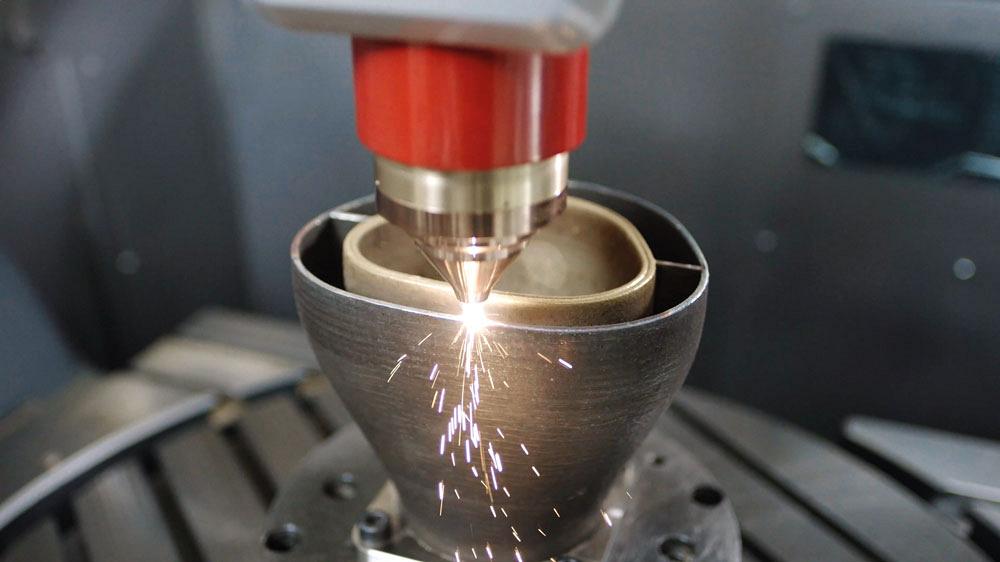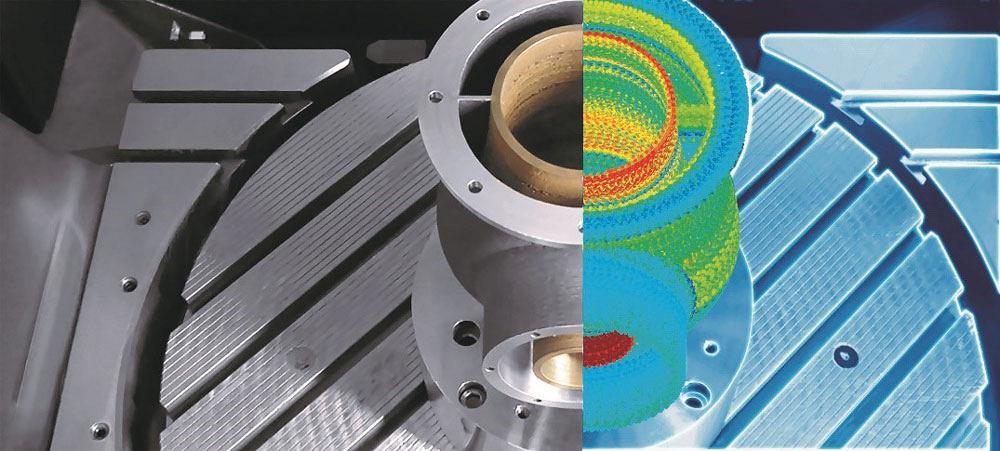Editor
- FMA
- The Fabricator
- FABTECH
- Canadian Metalworking
Technology Spotlight: Hybrid machining centre
A single part comprising dissimilar metals now can be created with additive/subtractive machining
- By Joe Thompson
- February 3, 2020
- Article
- Metalworking
Additive manufacturing (AM) is becoming increasingly established as a suitable process for metal part production. The demands placed on the technology are therefore also changing, which has led to the creation of hybrid additive/subtractive machines.
DMG Mori first introduced hybrid laser deposition welding and 5-axis simultaneous machining in a single setup in 2013 with the introduction of the LASERTEC 65. Gradually the line was expanded, first with the LASERTEC 4300 3D hybrid, which combines AM using a powder nozzle and turn/mill machining in one work area, and then the LASERTEC SLM powder bed machines.
Now with the LASERTEC 125 3D hybrid, the company has expanded its laser deposition welding portfolio to include a model for the maintenance, repair, and production of larger parts.
Based on the monoBLOCK series, the machine is designed for parts measuring up to ø1,250 by 745 mm and with a workpiece weight of up to 2,000 kg.
The automatic changeover between laser deposition welding and 5-axis simultaneous milling in a single setup reduces processing times by up to 80 per cent, the company states. These savings are achieved by eliminating process steps such as heat treatment, because the machine can deposit material with a hardness of up to 63 HRC.
According to the manufacturer, the alternating use of laser deposition welding and 5-axis simultaneous milling is particularly beneficial for improving production processes, enabling new component geometries, and repairing existing parts.
Examples of this work include the complete production of closed impellers and the repair of forming and forging dies for hot and cold forming. Cutter blades, for example, can be back in use within one shift thanks to powder nozzle technology, the company reports.
The hybrid machine can also produce lightweight structures that reduce the weight of parts like turbine blades by as much as 90 per cent.
New possibilities
A unique feature of laser deposition welding is that you can change between two materials quickly. Hard welding to reduce wear can be carried out in one area of a part, while at the same time, corrosion-resistant welding can be performed in another area.
Parts with advanced cooling performance also can be created. With this technology, a core made of bronze that dissipates heat quickly can be welded into die-casting moulds with an outer skin made of tool steel.

The DMG Mori LASERTEC 125 3D hybrid additive/subtractive machine is suitable for processing workpieces up to ø1,250 by 745 mm and 2,000 kg.
“Applying materials to specific areas of the part’s geometry allows us to combine various strengths of different materials in a single part and, therefore, push part performance,” said Nils Niemeyer, manager - sales and service, additive manufacturing for DMG Mori USA. “Take a cutting knife, for example. We can build the body out of a soft tool steel to allow better damping, longevity, and easier machining. To lengthen the tool life further, we coat the entire cutting edge with a HSS that increases the cutting edge’s hardness and wears slower.”
Another example is the combustion chamber of rocket engines. Internal layers of copper allow for the best heat conductivity, but they become weak at high temperatures. When the chamber is cladded with INCONEL® alloy, heat resistance of the chamber increases. In both cases, the material with the desired properties can be used in the location where it is needed.
Cost-effective repair
In the past five years laser deposition welding has emerged as an option for repair and coating work in many industries.
With this latest hybrid machine, manufacturers can now also process large damaged parts such as dies. The damaged area is first prepared by milling before the repair is carried out with laser deposition welding. The part is then finished in a final milling operation.
It all comes down to a new way of thinking about part creation.
“The main challenge is to divide the part features into sections that can be easily built up and machined. For example, in conventional machining we would divide a shaft with a pocket into two operations: turn diameter and mill pocket. We need to apply similar thinking for additive parts,” said Niemeyer.
Software manages production
Like its sister models, this new hybrid machine can be integrated into the hybrid CAD/CAM process chain. The Siemens NX hybrid CAM system even enables end-to-end programming of repairs. Programmers can seamlessly change between machining and laser deposition welding during the programming phase, and all process steps are then sent to the machine in one program.
There are multiple ways of approaching a part design. Typically, a programmer develops their preferred way of slicing a part and applies the operations sequentially.
“Together with Siemens, we have developed an AM hybrid bundle in Siemens NX that allows us to not only design for additive, but actually CNC-program for additive,” said Niemeyer. “We developed additive build-up strategies, such as building thin walls, coating 3D surfaces, and even grading multiple materials along the build-up curve. Part complexity is reduced into simplified operations.”
AM Assistant, part of the software and hardware package, includes an integrated thermal imaging camera for continuous thermal monitoring of the entire component or defined areas, monitoring of the melt pool size and temperature, and monitoring of the clearance between the nozzle and component.
Threshold values for all relevant process parameters, such as powder volume, working distance, and inert gas volume, can be stored using the input mask AM Guard, which also is part of AM Assistant. If these values are exceeded or undercut, the build is interrupted and then started again after a correction has been made.
AM Evaluator software is a downstream evaluation software for 3D process data. It can be used for the graphic display of this data from the production stage for evaluation purposes.
Data from the melt pool analysis, powder flow monitoring, and laser power can be analyzed individually and compared with each other and with previous build jobs. Automatic generation of reports for quality assurance in production is also possible.
This enables detailed analysis of process data for improving process stability.
Editor Joe Thompson can be reached at jthompson@canadianmetalworking.com.
DMG Mori, www.dmgmori.com
About the Author

Joe Thompson
416-1154 Warden Avenue
Toronto, M1R 0A1 Canada
905-315-8226
Joe Thompson has been covering the Canadian manufacturing sector for more than two decades. He is responsible for the day-to-day editorial direction of the magazine, providing a uniquely Canadian look at the world of metal manufacturing.
An award-winning writer and graduate of the Sheridan College journalism program, he has published articles worldwide in a variety of industries, including manufacturing, pharmaceutical, medical, infrastructure, and entertainment.
Related Companies
subscribe now


Keep up to date with the latest news, events, and technology for all things metal from our pair of monthly magazines written specifically for Canadian manufacturers!
Start Your Free Subscription- Trending Articles
Automating additive manufacturing

Sustainability Analyzer Tool helps users measure and reduce carbon footprint

GF Machining Solutions names managing director and head of market region North and Central Americas

Mitutoyo updates its end-user portal

Enhance surface finish with high-speed machining

- Industry Events
CTMA Economic Uncertainty: Helping You Navigate Kitchener Seminar
- May 2, 2024
- Kitchener, ON Canada
Automate 2024
- May 6 - 9, 2024
- Chicago, IL
ANCA Open House
- May 7 - 8, 2024
- Wixom, MI
17th annual Joint Open House
- May 8 - 9, 2024
- Oakville and Mississauga, ON Canada
MME Saskatoon
- May 28, 2024
- Saskatoon, SK Canada

















